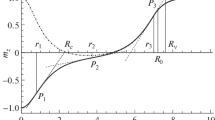Abstract
Vortex-like inhomogeneities that can appear in ferromagnetic films with strong easy-plane uniaxial anisotropy in the presence of antidotes in the form of artificial nanoscale holes or nonmagnetic inclusions are investigated. Peculiarities of the structure of such type of nanoobjects are considered for various geometries of holes, and the effect of demagnetizing fields on vortex-like inhomogeneities localized near one, two, or four holes is analyzed. It is shown that the analytic estimates obtained here are in all cases in good agreement with the results of numerical simulation.





Similar content being viewed by others
REFERENCES
T. Shinjo, T. Okuno, R. Hassdorf, et al., Science (Washington, DC, U. S.) 289, 930 (2000).
S. Muhlbauer, F. Jonietz, C. Pfleiderer, et al., Science (Washington, DC, U. S.) 323, 915 (2009).
M. Lee W. Kang, Y. Onose, et al., Phys. Rev. Lett. 102, 186601 (2009).
T. Schulz, R. Ritz, A. Bauer, et al., Nat. Phys. 8, 301 (2012).
K. Everschor-Sitte, J. Masell, R. M. Reeve, et al., J. Appl. Phys. 124, 240901 (2018).
M. V. Sapozhnikov, O. V. Ermolaeva, E. V. Skorokhodov, N. S. Gusev, and M. N. Drozdov, JETP Lett. 107, 364 (2018).
J. Zang, M. Mostovoy, I. H. Han, et al., Phys. Rev. Lett. 107, 136804 (2011).
G. Srinivasan, A. Sengupta, and K. Roy, Sci. Rep. 6, 29545 (2016).
E. B. Magadeev and R. M. Vakhitov, Bull. Russ. Acad. Sci.: Phys. 77, 1283 (2013).
E. B. Magadeev and R. M. Vakhitov, JETP Lett. 115, 114 (2022).
D. Navas, R. V. Verba, A. Hierro-Rodriguez, et al., APL Matter. 7, 0811114 (2019).
A. R. Pereira, J. Appl. Phys. 97, 094303 (2005).
F. A. Apolonio, W. A. Moria-Melo, F. P. Crisafuli, et al., J. Appl. Phys. 106, 084320 (2009).
D. Toscano, S. A. Leonel, P. Z. Coura, et al., Appl. Phys. Lett. 101, 252402 (2012).
J. Muller and A. Rosch, Phys. Rev. B 91, 054410 (2015).
M. Xu, J. Zhang, D. Meng, et al., Phys. Lett. A 433, 128034 (2022).
Yu. I. Latyshev, A. P. Orlov, A. V. Frolov, V. A. Volkov, I. V. Zagorodnev, V. A. Skuratov, Yu. V. Petrov, O. F. Vyvenko, D. Yu. Ivanov, M. Konczykowski, and P. Monceau, JETP Lett. 98, 214 (2013).
U. Welp, V. K. Vlasko-Vlasov, G. W. Cratree, et al., Appl. Phys. Lett. 79, 1315 (2001).
M. V. Sapozhnikov, S. N. Vdovichev, O. L. Ermolaeva, et al., Appl. Phys. Lett. 109, 042406 (2016).
E. Valdes-Bango, M. Velez, L. M. Alvarez-Prado, et al., AIP Adv. 7, 056303 (2017).
M. J. Donahue and D. G. Porter, OOMMF User’s Guide, Version 2.0a3 (Natl. Inst. Stand. Technol., Gaithersburg, MD, USA, 2021).
A. Hubert and R. Shafer, Magnetic Domains (Spinger, Berlin, 2007).
Y. Nakatani, K. Yamada, and A. Hirohata, Sci. Rep. 9, 13475 (2019).
Funding
This study was performed under the State assignment for laboratory research works (no. MN-8/1356 from 20.09.2021).
Author information
Authors and Affiliations
Corresponding author
Ethics declarations
The authors declare that they have no conflicts of interest.
Additional information
Translated by N. Wadhwa
APPENDIX A. CALCULATION OF ENERGY OF THE STATE LOCALIZED ON TWO HOLES
APPENDIX A. CALCULATION OF ENERGY OF THE STATE LOCALIZED ON TWO HOLES
To begin with, we note that vector ∇ϕ in polar coordinate system (r, ϕ) is equal in magnitude to vector r/r2 and forms a constant angle of π/2 with it. Taking this into account and substituting relation (2) into (1), we obtain
where
The integration domain for G1 is the entire plane except circles r1 < R1 and r2 < R2. However, the integrand of the expression for G1 in region r2 < R2 is close to a–2; consequently, circle r2 < R2 can be included into the integration domain without the loss of accuracy of the result. Then
Evaluating this integral considering that \(r_{2}^{2}\) = \(r_{1}^{2}\) + a2 + 2r1acosϕ1 and neglecting terms of order (R1/a)4, we obtain G1 = 2πln(a/R1). Analogously, G2 = 2πln(a/R2), which gives expression (3).
1.1 APPENDIX B. CALCULATION OF ENERGY OF THE STATE LOCALIZED ON FOUR HOLES
The magnetization distribution corresponding to the third inhomogeneity in Fig. 3 is described by the following relation analogous to expression (2):
where the holes are numbered clockwise. Analogously to Appendix A, we obtain
Using identity
and taking into account the system symmetry, we obtain E = Ah(4M1 – 2M2), where
Disregarding the fact that the circles corresponding to holes 3 and 4 are not contained in integration domain of M1 and repeating the arguments used in Appendix A, we obtain M1 = 4πln(a/R). Integral M2 differs from M1 only in the distance between the centers of the circles, which equals a\(\sqrt 2 \) in the case of circles 1 and 3. Consequently, M2 = 2πln(a\(\sqrt 2 \)/R), which finally gives E = 8πAhln(a/R\(\sqrt 2 \)).
Rights and permissions
About this article
Cite this article
Magadeev, E.B., Vakhitov, R.M. & Kanbekov, R.R. Theory of Vortex-Like Structures in Perforated Magnetic Films Accounting Demagnetizing Fields. J. Exp. Theor. Phys. 135, 364–371 (2022). https://doi.org/10.1134/S1063776122090151
Received:
Revised:
Accepted:
Published:
Issue Date:
DOI: https://doi.org/10.1134/S1063776122090151



